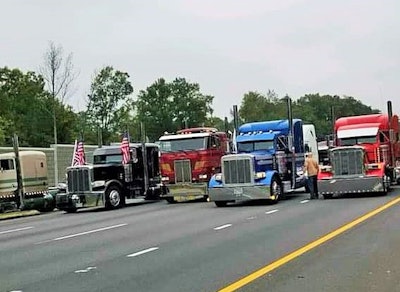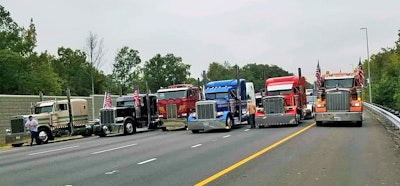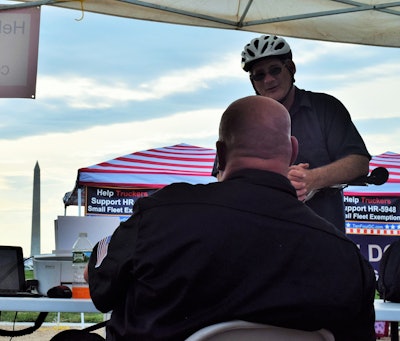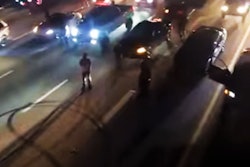
 The scene Saturday morning headed out of D.C. on I-95 with a convoy en route back to Fredericksburg, Va., as “10-4 on D.C.” convoy participants momentarily stopped traffic. Event and United States Transportation Alliance rep Brian Brase (in the blue Pete at center above) called this and one other brief stop (on I-395) a “warning shot” intended to give regulators/legislators a hint at what alternatively could result from failure to act on drivers’ concerns.
The scene Saturday morning headed out of D.C. on I-95 with a convoy en route back to Fredericksburg, Va., as “10-4 on D.C.” convoy participants momentarily stopped traffic. Event and United States Transportation Alliance rep Brian Brase (in the blue Pete at center above) called this and one other brief stop (on I-395) a “warning shot” intended to give regulators/legislators a hint at what alternatively could result from failure to act on drivers’ concerns.I had flown out of town before the final day Saturday of “That’s a Big 10-4 on D.C.” out on the National Mall in Washington, D.C. Participants in the 50-truck show/demonstration there convoyed out of the city toward the final Fredericksburg, Va., rally point that morning and, along the way, nodded to highway-stoppage actions of the 1970s by staging a couple of brief (approximately five-minute, or shorter, according to participants) traffic stoppages. A little bit of a disruptive photo-op, as it were, including one image that’s been floating around with a participating trucker extending both hands’ longest digits to the camera in front of a line of trucks across the highway.
Truckers involved, it’s sure, banked on more positive than negative PR among industry participants coming out of the action, but there’s been no shortage of both. There’s clearly a wellspring of support for the event overall among truckers who feel the time has come for more high-profile displays of unity among owner-ops and drivers, many of different persuasions when it comes to solutions and tactics. But there have also been plenty categorical cries of “these folks do not represent me” on social media, whether quick reactions of disgust with the aforementioned trucker and his raised fingers or more considered objections to the notion of stopping traffic as a means of sending any worthy message.

Representing TruckerNation during the 10-4 event, owner-operator Brian Bucenell, whose Peterbilt is pictured second from the right in the photo up top, had this to say about it all looking back over the last year: “All this stuff that we’ve done, we haven’t really gotten that far. We’ve moved a lot farther than we ever thought we could have, but we’re still talking about hours of service, ELDs have been implemented, parking still sucks – we need things to move at trucker speed.”
As has become something a norm for these D.C. actions, press coverage continued to be nonexistent outside of trade press as of Monday morning.
As positive commendation and negative blowback continue to come in for the brief highway stoppages, another, deeper element of blowback was on offer from a statistic long cherished by small trucking.
Distribution of for-hire trucking companies by fleet size
The source for the above breakdown is federal data mined by Overdrive sister data company RigDig Business Intelligence. What it shows is a fleet-size distribution of trucking-company entities with some kind of for-hire operating authority. It’s RigDig’s attempt to get at the reality of the transport sector most of Overdrive‘s audience participates in, hauling freight for-hire over the road or regionally. While there is no perfect way to isolate the sector entirely, the graphs bears out something of a maxim among owner-operator and small-fleet interests that has been repeated ad infinitum through my decade and more covering the trucking world.
That maxim goes something like this: Companies of less than 10 trucks (or less than 20, or insert your own preferred small number) control more than 90 percent of the industry.
That’s true from a number-of-companies/number of authorities perspective, as shown above, but when it comes the number of trucks those companies control that RigDig can see some evidence (vehicle registrations, inspections and the like) of actually operating in recent years, the breakdown among this particular set of fleets large and small with authority tells a different story.
Distribution of power-unit numbers within for-hire trucking companies, by company size
The reason I bring it up is that in regulatory discussions of H.R. 5948, the bill that would exempt carriers that own or operate 10 or fewer trucks (and the Owner-Operator Independent Drivers Association’s petition that would have done similar, but which offered an annual-revenue figure as the cutoff point for the exemption), several 10-4 participants noted regulators justified denial of the OOIDA petition and unworkable nature of a small-fleet exemption generally in conversation on grounds that “it would exempt 90 percent [or more] of the industry” from electronic logs.
That depends on how you define industry. By the power-unit-numbers graph above, when it comes to number of trucks, the exemption in the H.R. 5948 legislation would not affect 90 percent of the industry but closer to 10 percent, the approximate share of for-hire trucks controlled by fleets of 9 trucks or less. (Given the structure of many fleets operating across the size spectrum, made up as they are of numerous smaller entities, there are of course solid arguments to be made that small business generally is represented in much higher numbers than that in trucking writ large. For purposes of H.R. 5948, however, the exemption would be granted under the legislation, if passed, to companies with just 10 or fewer trucks running under the authority of the motor carrier, as I read it, whether those trucks are company or leased owner-op or small fleet units — for instance, a five-truck small fleet leased to, say, Landstar wouldn’t qualify for the exemption. The numbers above are broken out by operating authority, too.)
Emphasizing the importance of small trucking, advocates have hammered on the “90 percent of the industry” language for so long, it seems, even regulators may have internalized it, and in this case it’s not helping those who hope for a small-fleet exemption to the ELD mandate. There’s time yet to underscore the reality, as the current Congress comes to a close past the end of the year, and many 10-4 participants clearly were advocating for the H.R. 5948 bill in addition to airing concerns around hours of service, training, parking and other areas.
 Owner-operator Doug Hasner talks to a member of the public in the central area of the 10-4 show on the National Mall Thursday-Saturday this past week. Note the sign referencing the H.R. 5948 ELD small fleet exemption bill in the background to the right of the cyclist.
Owner-operator Doug Hasner talks to a member of the public in the central area of the 10-4 show on the National Mall Thursday-Saturday this past week. Note the sign referencing the H.R. 5948 ELD small fleet exemption bill in the background to the right of the cyclist.Owner-operator Todd Campbell of the ag/short-haul Campbell Farms small fleet took a meeting with aides to his Congressional rep on Thursday of the event last week. That’s Republican Brad Wenstrup of the 2nd District of Ohio. “We’ve seen a vast knowledge improvement,” Campbell says, among aides since visiting with the office in April of this year, the last time Campbell was in D.C.
“They’re in support of H.R. 5948,” he says, and noted that the office had been receiving information since then via OOIDA and other channels. “I send stuff constantly, too. … They’re getting on-board and supporting. Not openly — but vote-wise, they’re signaling they’ll support it.” Indeed, Wenstrup has not officially come on board as a cosponsor as of the latest available tally.
With time running out in this legislative cycle, the ELD mandate small fleet exemption bill has just 36 cosponsors, and prospects for it coming up for a vote I’d guess might be slim, though time will tell.









